Crawler market booms across North America
12 July 2021
The crawler crane market continues to heat up.
As the Covid-19 pandemic wanes, the construction industry is gaining steam. Crane fleet utilization, which was fairly flat during the dark days of the pandemic, is rising, especially the market for 200-ton plus capacity lattice boom crawlers.
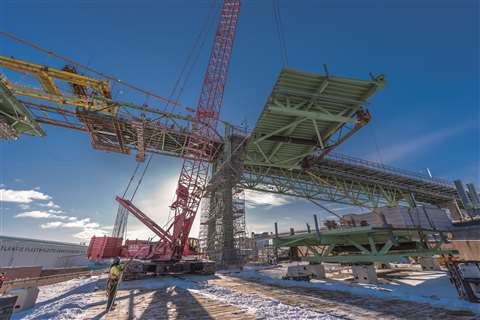 ALL Family of Companies
ALL Family of Companies
“The market for 200-plus ton capacity crawlers – and, indeed, all crawlers – is strong,” said Rick Mikut, crawler crane division manager, ALL Family of Companies. “I’m encouraged by the utilization rates we’re seeing, especially when you consider the lingering effects of the pandemic that continue to be felt. Across the board, our customers are experiencing supply chain issues that are impacting their ability to schedule cranes for their jobs. Consequently, some work has been pushed into next year. So, while it’s been an unpredictable time and utilization rates are off, given the extraordinary circumstances of the last year, the outlook remains solid.”
 Sany SCA1000A
Sany SCA1000A
SANY America’s new generation of cranes, including the SCA1000A crawler crane, are all built with the same intelligent technology and backed by a three-year, 3,000-hour warranty and solid aftermarket support, the company said.
With 110-ton lifting capacity at 12.5 feet, the SCA1000A comes loaded with the standard features typically found on larger cranes, Sany said. It has a main boom of 210 feet and maximum boom/fixed jib combination of 170 feet and 74 feet and is powered by a tier four final 334 hp Cummins diesel engine at 2100 rpm. Main and auxiliary hoists operate independently with free fall to make the crane more efficient and there is a third winch for duty cycle work, Sany said.
The SCA1000A cranes are designed to be easy to assemble and offer streamlined transportability. Transport the base crane at 210 feet of boom with a counterweight on four trucks. A fifth truck would only be needed to haul the jib. A self-assembly cylinder on the boom base section allows to assemble your own machine. Carbody jacks are positioned to ease the assembly for track removal, if needed, and for track extensions.
This entire crane has been designed with operator visibility and safety in mind. Operators have a commanding view of the surrounding jobsite with large windows all the way around the cab and top glass visibility with a retractable sunscreen to reduce glare.
Mikut said wind energy and industrial plant work are leading the pack.
“This is advantageous because plants can use crawlers of varying weight classes, starting with 200-ton all the way up to 400- and 500-ton and beyond,” he said. “And for wind, crawlers with longer booms are in high demand due to the growing height of today’s wind turbines, which are typically in the 90- to 110-meter range.”
A time to buy
Crawler cranes in the 200-ton capacity range are workhorses for bridge work, construction, wind farms and plant work.
“Wind is really surging and has been for quite some time,” Mikut said. “As the number of wind farms continues to rise and the height of the turbines grows, we have continued to invest in crawlers. In recent months, we’ve added a Liebherr LR 1800 and five new Manitowoc units including three additional MLC300 VPV Series 3 and two Manitowoc 14000 Series 3 and three MLC300 VPC Series 3. When we made that purchase, we also acquired attachments – two MLC650 VPC wide boom attachments and one each of 14000 luffing jib, 999 luffing jib, MLC300 VPC wide boom attachment, MLC300 VPC-MAX attachment and MLC650 VPC-MAX attachment.”
A few obstacles are holding back the market, Mikut said.
“In addition to the supply chain problems, there have been difficulties related to labor,” he said. “We’re coming out of it now but think back to just a few months ago when guys might have to quarantine for 14 days before entering a new state to work, then work for three weeks, then have to quarantine another 14 days before they could go home. In that scenario, they would be out four weeks’ pay. So, understandably, a lot of workers elected to avoid travel. That impacts the ability to get cranes out there. Now factor in those different states had different rules, and you can begin to understand the difficulty.”
Larger capacity crawlers are making the biggest comeback, he said.
“The edge probably goes to crawlers in the 400-ton and 500-ton capacity range,” Mikut explained.
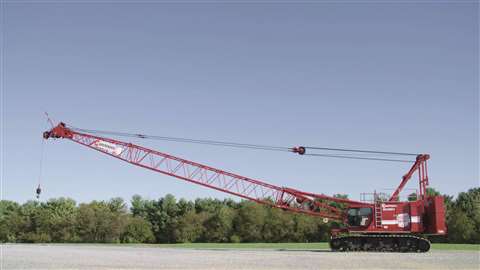 Manitowoc MLC100-1
Manitowoc MLC100-1
In recent years Manitowoc has added two new models to its range of crawler cranes: the MLC100-1 and MLC150-1. These cranes are known for their competitive load charts, jobsite maneuverability and transportability.
The MLC150-1 saves customers time on the jobsite because of its self-assembly hook that enables the operator to install the counterweight without any outside assistance, the company said. The boom butt mounted sheave enables self-assembly without the boom top. It features a button-style rope termination, and gantry-raised counterweights reduce components. The crane is also easier to transport. The boom cap, jib butt and struts ship as a single package for fewer connections. An increased hook height enables self-assembly with various trailer heights, and the crane is designed to be transported with minimal permitted loads.
Both the MLC100-1 and the MLC150-1 have improved wider cab designs with easier access made possible by additional grab bars and movable left-hand consoles. The cab design offers more legroom, high-back seats with head rests and electronic seat controls, combined with improved HVAC performance.
The cranes also allow for easier service than ever with high-visibility sight glasses and quick drains on every gear box. Their main valve is also easily accessible. The cranes operate via Manitowoc’s Crane Control System (CCS) which can be used in conjunction with the company’s new Diagnostic Code App to quickly analyze diagnostic screens.
“A big component of The Manitowoc Way is listening to exactly what our customers need and want in their cranes,” said Brennan Seeliger, product manager, Manitowoc Cranes. “They asked for a reliable crawler that can get to work faster than any competing crane.”
Saturated market
Lampson International rents crawler cranes throughout the world and especially in the western United States. Kate Lampson said the market for crawlers is “good, but it could be better.”
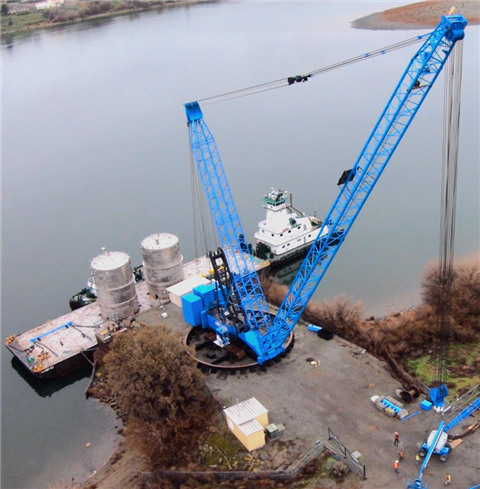 Lampson International
Lampson International
“Power plants, bridge work, new building construction, wind tower erection and marine applications for the Lampson Millennium 4100 and 4600 crawler cranes with Ringer attachments,” she said. “We are seeing nationwide demand for the Manitowoc 16000s, 2250s and the Lampson Millennium 4100 and 4600 crawler cranes, which can be equipped with Ringer attachments, as well as the Lampson Transi-Lift.
There are still a few issues in the market.
“A saturated crane market, lack of premium projects and delays in the oil and gas industry are all contributors to a stalled market,” she said. “The cancellation of the Excel pipeline by the current administration has hindered the market as well. It is our opinion that if the current administration would allow projects such as the Excel pipeline to go through as well as to support the coal and oil and gas industries, we would see a great deal more work for these cranes in the United States.”
She said Lampson will make an investment in additional cranes if they have a project or projects that warrant(s) adding new gear to the fleet.
“We are seeing a demand in the 200-ton to 600-ton capacity class for traditional crawler cranes as well as the 1,100-ton to 3,000-ton range for the Lampson Transi-Lift,” she said. “We are seeing that crane rentals have remained steady coming out of the pandemic, however, with excess gear on the market and fewer projects, rates will continue to be depressed.”
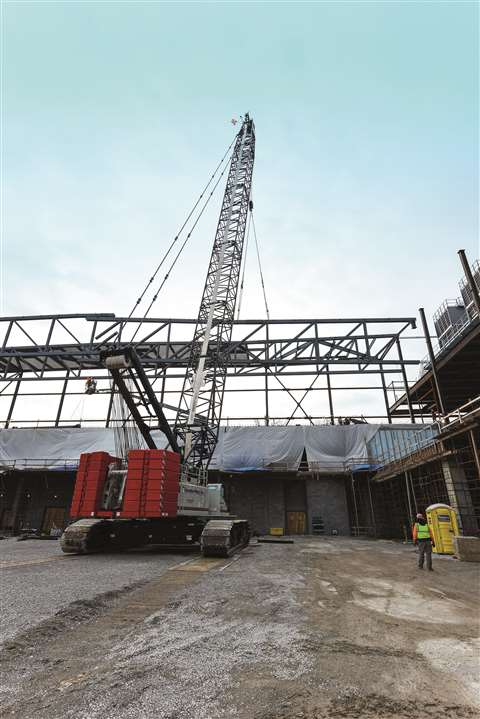 Link-Belt 348 Series 2
Link-Belt 348 Series 2
Link-Belt Cranes made its debut of the new combination top for the 300-ton capacity 348 Series 2 at ConExpo 2020. The heavy-duty combination top boom section is built for conventional boom makeup or luffing boom configuration. Bar pendants connect main boom, luffing jib and luffer back stay. New to the heavy-duty boom extension is backstay bar pendant storage. This allows the 348 Series 2 to go to work with heavy-duty boom while the luffer backstay pendants are stored on the conventional boom. The hook and pin design greatly simplifies the process of mating the combination top with the luffing jib base section. Lattice style front and rear posts further reduce transport weight.
Maximum heavy-duty boom length is 300 feet and maximum heavy-duty jib combination is 240 feet plus 140 feet. Maximum long-range boom length is 355 feet and maximum long range jib combination is 295 feet plus 140 feet. A maximum combination of 180 feet of luffing boom and 240 feet of luffing jib provides 420 feet of attachment and a tip height of 419 feet. In addition, 348H5 heavy duty and long-range extensions are interchangeable with the 348 Series 2.
The 348 Series 2 completely self-assembles with a live mast quick draw cylinder. To accommodate varying transport regulations, the 348 Series 2 main unit transports under 100,000 pounds.
Supply chain woes
Bigge Crane & Rigging is seeing strong demand for crawlers across all industries in the markets it serves. Because a lot of work was postponed or even cancelled during the pandemic, some work has been slow to return because of lingering challenges that have been exacerbated by the supply chain, Bigge said.
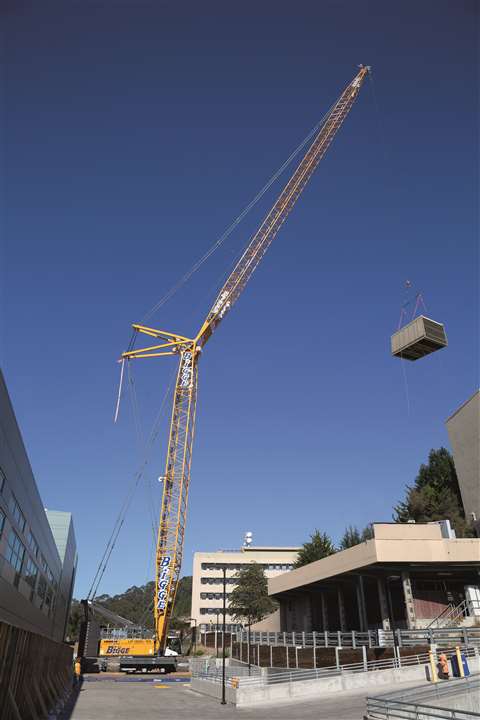 Bigge Crane & Rigging
Bigge Crane & Rigging
“We are seeing utilization continuing to climb and nearing pre-pandemic levels, and we are anticipating a full recovery within the next few months,” said Bigge’s Joe Nelms. “We are prepared for further growth and are currently evaluating several new markets as part of our expansion strategy.”
Bigge has been buying, renting and selling new and used crawler cranes throughout 2020 and 2021, and has grown its crawler fleet by more than 60 cranes over the last year, Nelms said.
“We are completely prepared with what we call ‘the perfect fleet’ for the growth we are forecasting for the balance of this year and in 2022,” he said. “We have more than 120 crawler cranes on order for delivery between now and the end of 2022.”
Bigge is seeing demand for all crawler capacities from 110 tons up through 1,100 tons in capacity.
“We are so confident in the demand that we have placed our largest orders ever for Liebherr crawler cranes,” he said “We have waves of LR 1110, LR1130, LR 1160, LR 1250, LR 1300.1 SX, LR 1400 SX, LR 1500, LR 1700, LR 1800 and LR 11000 being delivered on a regular basis. We also have a large mix of Liebherr, Link-Belt and Tadano telecrawlers on order. We are already the world’s largest owner of LR 1300s, and we have our sight set on becoming the world’s largest owner of Liebherr crawler cranes, period.”
As far as rental rates, some classes are better than others, but the rates throughout the category warrant continued market growth and expansion, Nelms said.
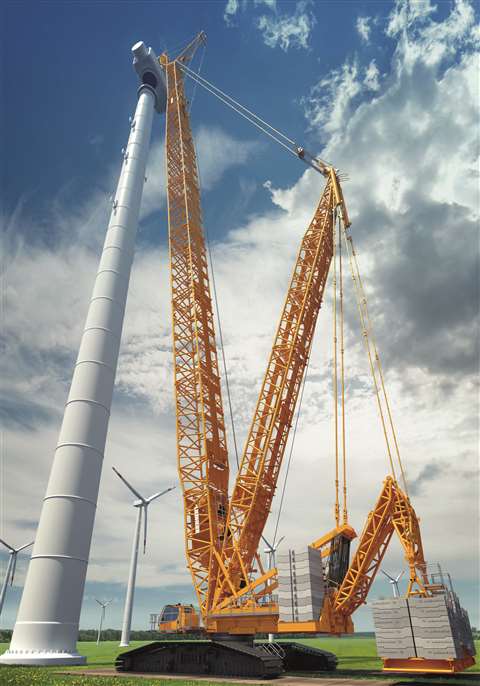 Liebherr LR 1700-1.0
Liebherr LR 1700-1.0
The new Liebherr LR 1700-1.0 combines the benefits of the low cost transport of 660-ton class crawler cranes with the performance of 825-ton class lattice boom cranes. It also features all the innovations of Liebherr’s crawler crane developments from the last few years, the company said.
The LR 1700-1.0 was designed on the basis of the dimensions of the LR 1600/2 – but with significantly more lifting capacity. A large number of components from the LR 1600/2 can be used for the LR 1700-1.0. The basis of the high performance of the LR 1700-1.0 is the new base machine, whose static structure has been completely redesigned to deliver up to 15 percent more lifting capacity.
The V-frame and VarioTray have more than proven their worth on the derrick of the LR 1800-1.0 and LR 11000 crawler cranes, and the LR 1700-1.0 also has these systems, the company said. VarioTray is a small ballast pallet, which can be unbolted quickly and easily when necessary. This avoids the need for stacking and unstacking of ballast slabs. The V-frame ballast system is a hydraulically adjustable folding frame that enables the ballast radius of the LR 1700-1.0 to be infinitely adjusted between 43 and 69 feet. A rigid ballast guide system is no longer required for large radii. The modern derrick system has V-frame, VarioTray and the new “M-Wagon” modular ballast trailer.
Renewed focus
Buckner HeavyLift Sales Director Sarah Perez said Buckner has a renewed focus on commercial projects. A leader in wind tower erection, Buckner is working to diversify its markets even further.
“I believe that just as other markets were impacted by the pandemic so was the crawler crane market,” Perez said. “However, the upside to the crawler crane market is its diversification, so while some projects were put on hold, like stadiums and plant shutdowns, others, like commercial distribution centers and wind farms, have continued construction throughout the past year. Now with at least half of the U.S. population vaccinated, we are starting to see the projects that were put on hold come back and we believe the crawler crane market is going to get very busy over the next few months and stay that way for the foreseeable future.”
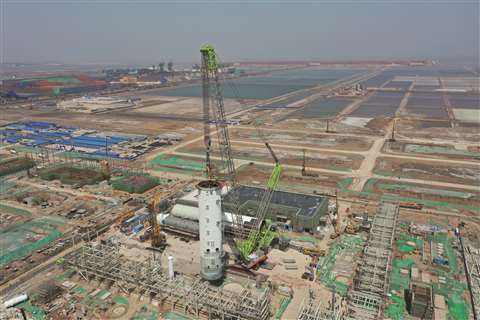 Zoomlion ZCC32000
Zoomlion ZCC32000
The Zoomlion ZCC32000 crawler is known as “leader of Optimus Prime” Zoomlion said. Its maximum lifting capacity reaches 2,200 tons, with a maximum lifting torque of 32,000 tm. The ZCC32000 has a power system of double engines plus hydraulic pump set, which allows the switch between single-engine and double-engine working modes for better fuel economy. The product is equipped with adaptive super lift counterweight luffing control system and double hook synchronous anti shake control. The wireless remote-control system, with comprehensive functions is perfect for harsh environments.
The largest utilization for crawler cranes is wind energy, she said. After wind, larger cranes are mostly utilized for industrial projects in the Gulf Coast and Midwest regions, and the smaller cranes are consistently utilized for precast and general steel erection projects throughout the country.
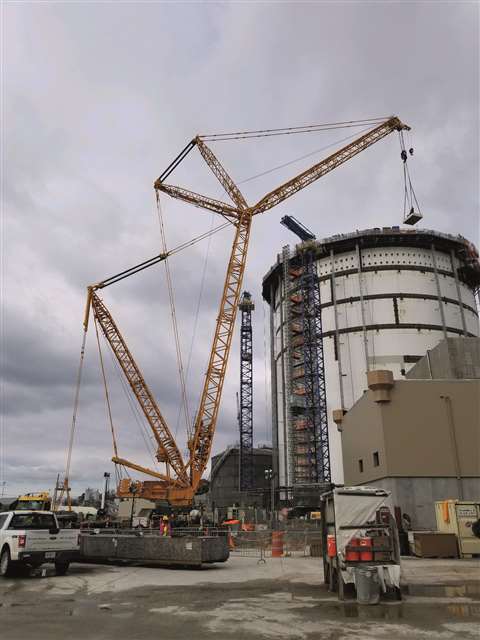 Buckner HeavyLift
Buckner HeavyLift
“However, one might say that geography is not a true indicator of utilization, but it is the projects that are the indicator and that is affected by drivers that we cannot always see,” Perez said. “Certainly commercial, infrastructure and stadiums are near large metropolitan areas to a great extent, while industrial and petroleum chemical follows the traditional established regions.”
Perez contends that when planning for a project, customers tend to make selections based on which cranes they are most familiar with.
“This can be a problem because their selection may not be the best crane for the project, or they may be limiting themselves when there is an availability shortage,” she said. “The way to overcome this obstacle is through education. At Buckner, we try to constantly educate ourselves on the latest crawlers and their capabilities, which is made easier by our constant communication with Liebherr, the manufacturer. We try to get involved with our customers early in the planning phase to understand what they are trying to achieve instead of just focusing on what crane they have asked for. By doing this, we can educate the customers on the various options that are available to them for their project that can potentially save them time and money. An example of a crane that customers may not be as familiar with is the LR1800, which is a crawler that has a maximum capacity of 880 tons and the unique feature of a v-frame ballast tray that allows greater flexibility to position the counterweight tray to improve crane capacity. This crane is ideal for industrial plants, power plant construction and the petrochemicals industry.”
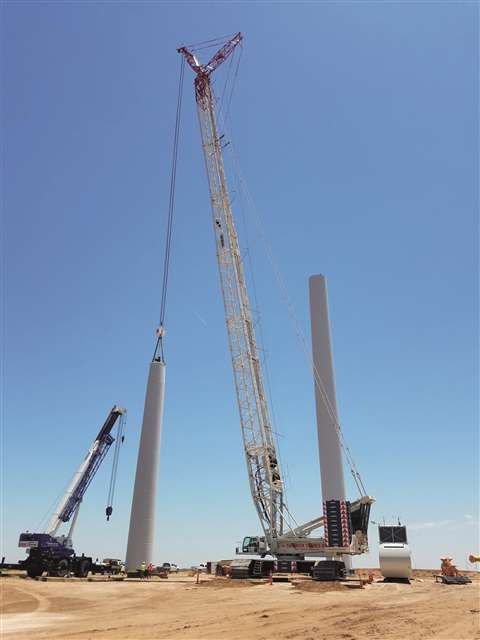 Tadano Demag 3800. Photo courtesy of Superior Cranes
Tadano Demag 3800. Photo courtesy of Superior Cranes
Tadano said interest in crawlers 660 to 750-ton capacity range has been increasing. The main driver is wind energy projects throughout the Midwest, South and West Coast, Tadano said. Infrastructure work is driving demand for lattice boom crawler cranes 300 tons and under. Tadano’s offering begins at 400 tons capacity.”
For Tadano, interest in the Demag 3800 model is very strong as it offers different configurations for higher lifts and heavier loads. A good example is the wind energy market where it continues to move towards higher hub heights and heavier components
“Tadano is constantly working to develop new and innovative technology,” Tadano said.
Buckner plans to purchase more LTR1220s, LR11000s, a LR13000 and potentially LR1300s.
More recently, the crawler crane that is getting the most requests by Buckner customers is the Liebherr LR1300, Perez said.
“It has the capabilities and flexibility to work in all applications from bridges to stadiums and it utilizes an easy-to use operating system,” she said. “We have also seen an uptick in requests for the 11350, specifically for upcoming plant shutdowns. Overall, though, our most in demand crane is the LR11000, which continues to be the rockstar crane in the wind industry.”
Buckner specializes in larger crawler cranes and these cranes command good rental rates due to supply and demand and the uniqueness of the cranes, as opposed to the more commodity pricing of certain other crane classes, Perez said.
“These are interesting times for everyone,” Perez summarized. “What helps us is being so diversified.”
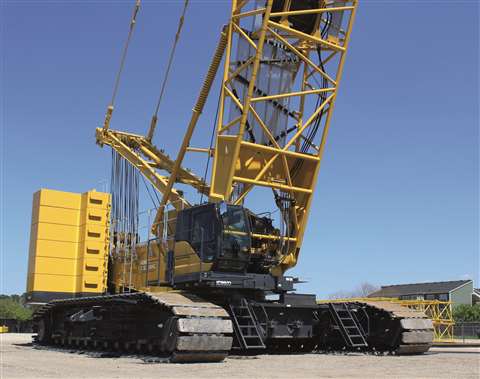 Kobelco CK3300G-2
Kobelco CK3300G-2
Kobelco launched its 330-ton CK3300G-2 into the North American market in 2018. The CK3300G-2 has been successful in a variety of applications, such as tilt-wall, steel erection, petrochemical plant construction, bridge work and cargo handling.
Operators and technicians appreciate the cab and control system commonality with other Kobelco models because it shortens their learning curve and adds to their confidence in the crane, according to Kobelco Cranes General Manager Greg Ballweg. Like other Kobelco models, the CK3300G-2 uses a simple hydraulic over hydraulic control system, resulting in smooth and predictable function speeds and response, he said.
Kobelco recently introduced a new heavy-duty fixed jib attachment for the CK3300G-2, known as the K2 model, with capacities nearly twice those of the previous fixed jib. The maximum capacity of the new K2 jib is 99,200 pounds.
The new jib offers the versatility of using main boom lengths from 98 feet up to 256 feet, and jib lengths from 40 feet up to 100 feet, with an overall maximum reach up to 290 feet.
Six different counterweight combinations for using the jib are available and programmed into the crane’s LMI system. This new K2 jib features a heavy-duty strut design, is easy to install with built-in lift lugs and pins directly to the standard main boom tip. Also, the 20-foot and 40-foot jib inserts share commonality with the CK850G main boom.
The next new crawler will be the CK2000G-2, a 200-ton rated crawler, expected to be available in early 2023.
STAY CONNECTED


Receive the information you need when you need it through our world-leading magazines, newsletters and daily briefings.




